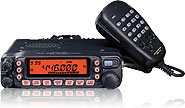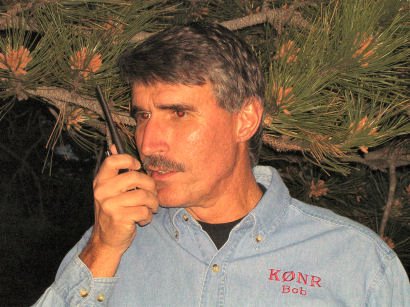The Use of 146.52 MHz
 One of the local clubs recently had a heated discussion about the use of the National Simplex Calling Frequency, which is 146.52 MHz in the US (per the ARRL band plan). You have probably heard the argument before.....is the calling frequency reserved to just calling or is it OK to ragchew on that frequency?
One of the local clubs recently had a heated discussion about the use of the National Simplex Calling Frequency, which is 146.52 MHz in the US (per the ARRL band plan). You have probably heard the argument before.....is the calling frequency reserved to just calling or is it OK to ragchew on that frequency?In the Summer 2006 issue of CQ VHF, I wrote about mountaintop operating and included these thoughts on the use of 146.52:
Calling FrequencyNow you have heard my opinion, what do you think?
What frequency are you going to use to call CQ from your favorite high spot? Well, the calling frequency, of course.... most likely 146.52 MHz. This usually works pretty well as many simplex-oriented operators make it a point to listen on .52. While we don't normally make long CQ calls on VHF FM, making a call such as "CQ Five Two,this is K 0 N R on Pikes Peak" is a good way to go.
One problem I've run into is when the calling frequency is tied up with lengthy contacts by other hams. If the frequency is in use, I generally just stand by and wait for them to finish. If it seems appropriate, I might break in and chat with them.
Disclaimer: It is difficult to write authoritatively in a national ham magazine about VHF issues that often tend to be regional in nature. What works in rural areas with lower population density may not apply in New York City. Ignoring that, I'll jump in with both feet (maybe with one in my mouth, who knows?)
What is the purpose of a calling frequency? Back in the old days of crystal controlled rigs it was important that we had common channels crystalled so we could talk to each other. We typically only had a dozen or so channels, so having a common calling or simplex frequency (or two) was an obvious thing to do. These days, we have synthesized 2M FM rigs that cover the entire 4 MHz band in 5 kHz steps. Now the purpose of a calling frequency is, well, for calling. You use 146.52 MHz when you want to establish contact on the band, lacking any other information. For example, if I know my buddy Steve KØSRW is going to be listening on the 146.94 MHz repeater, I'll call him there. If I know the local DX crew hangs on out 146.46 MHz, I'll make a call there. But when I don't have any other information, and I am making a call or listening for a call, I go to the calling frequency. Why? Because that's what it's for! If I am out of repeater range and I just want to talk to someone on simplex, I try the calling frequency.
The Three Minute Rule
There are two ways to make a calling frequency useless:
1. No one ever uses the calling frequency (nobody there, nobody home)
2. The calling frequency is always tied up due to lengthy contacts
So we need to encourage hams to monitor and use the calling frequency, but not monopolize it. We don't have to be extreme about it. Perhaps a "three minute" rule of thumb: if I am in a contact with another station on the calling frequency for more than 3 minutes, it is time to change to a different frequency. This opens up the frequency for other hams to use. Just as important it keeps the long ragchew sessions away from the calling frequency. These long sessions have a tendency to discourage monitoring of 146.52 MHz. One ham recently told me that he tries to keep a receiver tuned to .52 for anyone just passing through the area that might need some help. But when some of the locals get on the frequency and chat for an hour, the radio gets turned off.
There, I said it: the calling frequency is for calling, not for ragchewing.
73, Bob K0NR



4 Comments:
I agree with you -- in principle.
In practice, there is so little activity on 146.52 that I seriously doubt that ragchewing ever becomes a problem here.
And worse -- because of 52 being designated a "calling frequency" local groups here have all splintered off onto nearby frequencies. For instance, there is quite a bit of activity in this area on 146.565 FM simplex. But strangers passing through will never know that.
By making 146.52 a "calling frequency" my guess is that it's used even less than it could be -- which is the opposite effect from what is really desired.
73 de Jeff, KE9V
I also agree. I am an OTR truck driver and find very little use of simplex even on .52. Only in the more populated areas. I used operate
2m SSB and there is even less activity there unless there is a contest going on. There the calling frequency is 144.200, and I have been kinda kicked off of there a couple of times.
I look at it this way if you don't use the frequencies to talk on no one will know you are there. The three minute thing sounds really good to me.
So many times I hear people on repeaters that could be using simplex and if I remember the rules correctly stations should use simplex if at all possible.
Any how good suggestion on the 3 minute thing.
73 de K3ITG
Mark.
I guess I am guilty of raising the issue. I was actually taken aback by how quickly the tone of the discussion deteriorated.
I simply meant to ask the rationale behind having the entire net move for 10 minutes to the calling frequency and then moving to an alternate simplex frequency.
The argument seemed to break down into those folks who never leave home (or at least never leave their home repeater) and those who travel and do a lot of communications via ham radio.
Each group was passionate in defense of their position. The most disturbing defense to me was yeah, we know it's out of the band plan, but who does it hurt? The band plan is just a gentleman's agreement anyway, it's not the law. These folks actually seemed offended that I would even raise the question. In an off-reflector e-mail, my motives for speaking up were impugned.
No offense, but whether or not rag-chewing is a serious problem depends on whether you are the chewer or the one wanting to use the frequency. As the blog pointed out, ragchewing discourages monitoring. Leaving aside the example we set by our behaviour.
What came out of the discussion was edifying. There are many newly licensed hams who missed large chunks of "good operating practices" when they studied for their licenses. Apparently there are more and more licenses being handed to people who know how a radio operates, but are unaware of how to operate a radio. Some of us old timers could use a brush up, too.
As for ragchews on nearby frequencies being missed by travellers, many of us use the scan feature on our mobile rigs. We also generally keep a repeater directory handy.
73, de KC0PBR
Sharon
I love the 3 minute rule idea!
I think as with many things ham, when there are only a few folks around (either by population or who's on the air) we can get by with more loose interpretation of the rules. When more folks are around (i.e. in an emergency) we have to be more formal in our use.
As one who sits at his desk all day long with the radio on, scanning usually, I understand the point of view that a long rag chew gets the radio turned off. It does mine!
Remember that there are lurkers out there and just because you don't hear them doesn't mean they aren't there.
I believe in the concept of training the way you fight (old Army thing I guess) so I personally am a big advocate of keeping .52 for calling. AT the same time, I used it for over 6 hours once driving cross country taking with a couple of truckers. I've also moved an ARES training net to .52 for in-and-out check-ins.
I guess the bottom line is be mindful of your use, be considerate of others and consider the circumstances.
That's my 2 cents worth anyway!
Thom / K5JTR
Post a Comment
Links to this post:
Create a Link
<< Home